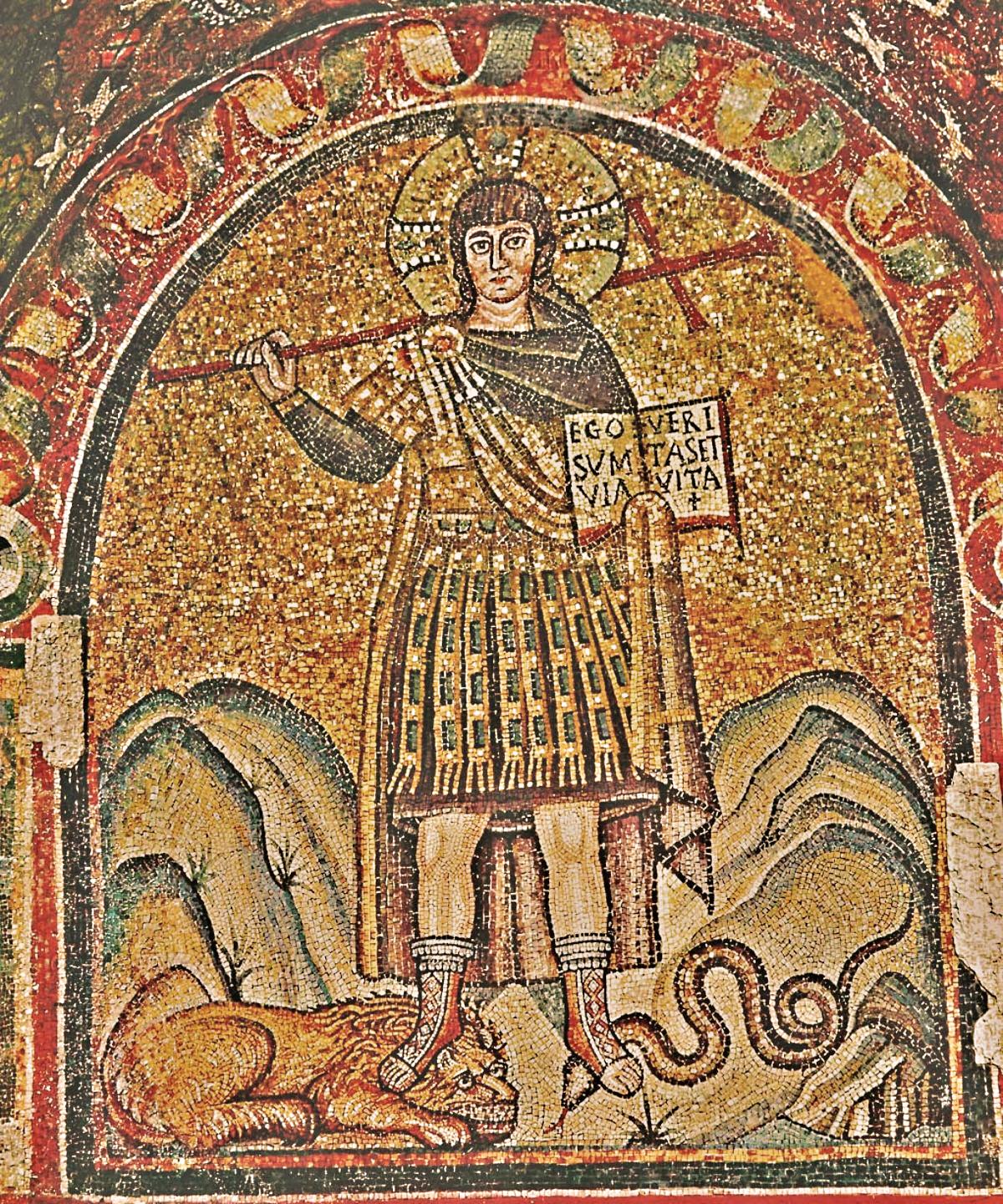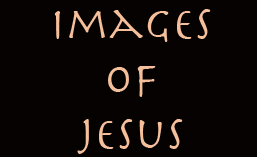
Christ Triumphant
[i]Diocletian split the Roman Empire in 286 into Eastern and Western halves.[ii] In the Western half, Constantine converted to Christianity in 312 AD and made Christianity legal in 313. [iii] He gave high priority to the Christian faith and the leaders of it. This necessarily changed the way Christian art was viewed because Christian art (and therefore images of Jesus) was now imperial art. During the rest of his reign as emperor, Constantine established a relationship between the church and the state that lasted through the middle ages up past the time of the crusades.
An interesting shift in the way Christians viewed images occurred during this time. People in Constantine’s age considered the emperor’s image as a valid substitute for the actual emperor. It was as if the emperor were actually there. The general attitude toward the imperial image became the general attitude toward Christ’s image. [iv]
This section will focus on Christ Triumphant, a painting on the archiepiscopal chapel that projects Jesus no longer as a humble shepherd, but as an emperor-type figure. The painting is dated from 494 to 519 AD and can be found in Ravenna, Italy.[v] While there are other types of Jesus, this one is an important one to focus on because it is a good example of the shift that happens from image of Jesus to icon of Jesus. It is with this image that people start looking at the image to see the person rather than the person’s attributes.
In this image, Christ has a halo and is standing with his feet on a lion and snake. He holds a book in one hand and a cross in another. He is dressed in rich clothing (a general’s uniform)[vi] with a jewel on his shoulder. This image is very different from the Good Shepherd, but there are similarities in that both images display a handsome, beardless man with curly hair. When looking at this picture, the audience would have probably likened it to a portrait or statue of an emperor. This reckoning would have had similar effects on the audience, it might have meant just like an imperial image that because the portrait of Jesus was there, Jesus himself was there.
In order to better understand the new attitude to portraits of Christ, let us first try to better understand the general attitude toward images of emperors. The proxy tradition of emperors did not end with Constantine. Emperors used their images as proxies even after acknowledging that they were not divine beings.
“The imperial image was a vital presence that commanded fear and obedience, receiving and dispensing all that was due the emperor himself. It witnessed official acts, presided over judicial hearings, enforced laws, guaranteed oaths, dispensed clemency, and accepted gifts and sacrifices.” [vii]
The above passage shows that people feared and respected the image of an emperor as much as they would the actual emperor. In Myth and Symbolism class, we talked about how people would be reluctant to tear up a picture of someone they respected because it was someone they respected. The proxy tradition could be considered a different version to this type of respect. It might also be considered something similar to a person kissing a poster[viii] of his or her favorite icon.
Evidence that the empirical proxy tradition did not die off with the event of Constantine’s conversion can be seen in Severian of Galaba who wrote:
“Since and emperor cannot be present to all persons, it is necessary to set up the statue of the emperor in law courts, market places, public assemblies, and theaters. In every place, in face, in which an official acts, the imperial effigy must be present, so that the emperor may thus confirm what takes place. For the emperor is only a human being, and he cannot be present everywhere.”[ix]
Some Christians resisted the shift of images of Jesus into portraits. There were iconoclasts who firmly resisted it, destroying images that were around. Iconodules who were for the images argued against the iconoclasts by suggesting, like the image of emperors, that the image of Jesus did have power. In 787 at The Council of Nicaea, they said “the honour which is paid to the image passes on to that which the image represents, and he who does worship to the image does worship to the person represented in it.”[x]
Despite adversity, this theology persisted throughout the middle ages. The idea of the icon developed further in later 6th and 7th centuries with the legend of Kamoulianai Christ (which hasn’t survived) and the archeiropoietos icons, or images not made by human hands.[xi] The shift from the imperial-looking Jesus to a Jesus supposedly not made by human hands shows a switch from the idea that the image of Jesus is a proxy of Jesus to the idea that the image of Jesus can act on behalf of Jesus. It also acts now as proof of the power of the actual Jesus.[xii] This might also be a good place to start when looking at the theological attempt to figure out what Jesus actually looked like.
In conclusion, as can be seen by the example of Christ Triumphant, the idea of images of Jesus shifted from an image of God reminiscent of pagan hero gods, to an image of God reminiscent of a Roman emperor. Portraits of Jesus were now seen to have power in captivating the audience and to stand as proxy for the actual Jesus. A viewer of the Christ Triumphant mosaic would have recognized the similarity to an emperor or a general, they would have still seen the similarity to pagan gods (youthfulness symbolic of immortality), but they would have noticed this Jesus no longer looks like the humble shepherd.
[i] (image) Christ Triumphant, mosaic, 494-519 AD, Ravenna: Archiepiscopal Chapel: Vestibule Mosaic, Italy. Art and Faith, Too. Site by Lisa Towers and Bill Jones. http://goo.gl/EM4tK (Accessed June 4, 2012).
[ii] ” Diocletian,” A Dictionary of World History, (Oxford University Press, 2000), 5 June 2012, http://www.oxfordreference.com/views/ENTRY.html?subview=Main&entry=t48.e1082 (accessed June 5, 2012).
[iii] Raymond Van Dam ” Constantine ” The Oxford Encyclopedia of Ancient Greece and Rome. Ed. Michael Gagarin. © Oxford University Press 2010, http://www.oxford-greecerome.com/entry?entry=t294.e299 (accessed June 5, 2012).
[iv] Alain Besançon, The Forbidden Image, trans. Jane Marie Todd, (Chicago: University of Chicago Press, 2000), 110.
[v] Christ Triumphant, mosaic, 494-519 AD, Ravenna: Archiepiscopal Chapel: Vestibule Mosaic, Italy. San Diego, University of California. ARTstor Slide Gallery. http://goo.gl/fuQFk
[vi] Eduard Syndicus, Early Christian Art, trans. J. R. Foster, (New York: Hawthorn Books, 1962), 98.
[vii] Robin Margaret Jensen, Face to Face. (Minneapolis: Fortress Press, 2005), 52
[viii] “Interactive Poster that Loves Being Kissed.” March 31, 2012. Video. Accessed June 5, 2012. http://www.youtube.com/watch?v=xyFZl7lCz_s
[ix] Robin Margaret Jensen, Face to Face. (Minneapolis: Fortress Press, 2005), 53
[x] Beth Williamson, Christian Art, (New York: Oxford University Press, 2004), 13
[xi] Anna Kartsonis, “The Responding Icon” in Heaven on Earth, Ed. Linda Safran, (University Park, Pennsylvania: The Pennsylvania Stat University Press, 1998), 65.
[xii] Ibid. 65
